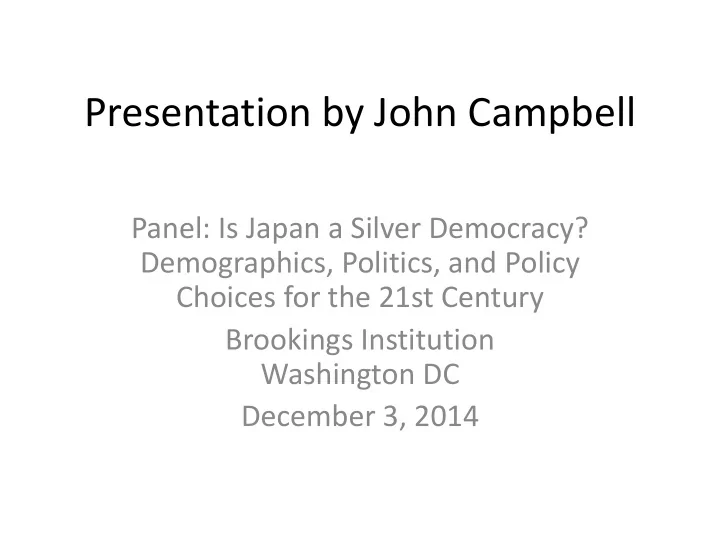

Presentation by John Campbell Panel: Is Japan a Silver Democracy? Demographics, Politics, and Policy Choices for the 21st Century Brookings Institution Washington DC December 3, 2014
Four themes in 12 minutes 1. Expansions of social programs for old people came when there weren’t many old people; when there were many, policy changes went against them 2. Japanese social policies for old people are not particularly generous any more 3. Future prospects aren’t so gloomy 4. Recommendations 2
Expansions when few old people • 1959: National Pension and Welfare Pension • 1963: Welfare law for the Aged, many programs • 1972: Double Welfare Pension benefit; free medical care (no co-pay) for 70+ • 1973: Double “model” Employee Pension benefit to ¥50,000/mo • [1989: “Gold Plan” to expand long-term care] 3
Cutbacks when more old people • Pension reforms cut future benefits in 1985 and 1995; major reform in 2005 indexed benefits to economy and demography • Co-pay for medical care reinstated in 1981 and raised in several steps (continuing) • Special health insurance system for 75+ raises premiums in 2008 • Long-term care insurance (LTCI) benefits trimmed, premiums raised 2003-2015 4
Political influence? • Yes in that politicians force postponements of co-pay increases etc. for 1-3 years • But that’s pretty trivial. Note that last week LDP said would protect child day care against revenue shortfall, not long-term care salary hikes or doctor home-visit fees • Current pension benefits will be cut 1.1% on April 1—announced before the election 5
So as of now . . . • With the partial exception of long-term care, social programs for old people are not particularly generous in Japan any more 6
Old-Age Social Spending/65+ pop 2011, $PPP, OECD 30.000 25.000 20.000 15.000 10.000 5.000 0.000 7
So as of now . . . • With the partial exception of long-term care, social programs for old people are not particularly generous in Japan any more • The advantage over young people in health insurance has dwindled sharply • Most importantly, Japanese pension benefits are among the worst in the world 8
Pensions for median worker entering the labor force as % of average wages (net of taxes) Japan 42.5%, US 49.9%, OECD 69.1% OECD calculations for 2011 9
Future prospects: the big problem • In the long term, Japan has to maintain growth with a shrinking, aging population • It is hard, but the good thing is that the problem gains slowly, so markets can adjust • E.g. the labor shortage – Not enough workers so wages go up – New workers come in; firms raise productivity – On the margin the number of migrants goes up • I leave this topic to my economist colleague 10
Future prospects: smaller problem • In the medium term Japan has to increase spending on medical care and LTC for another ten years—gets easier in 2025 11
Size of Population by Age Group over Time (in 1000s) Total 15-64 65+ 0-14
Future prospects: smaller problem • In the medium term Japan has to increase spending on medical care and LTC for another ten years—gets easier in 2025 • In medical care, Japan has succeeded in holding down spending despite rapid aging— it will continue to do so 13
Medical care spending per capita $PPP 2011 OECD 14
Future prospects: smaller problem • In the medium term Japan has to increase spending on medical care and LTC for another ten years—gets easier in 2025 • In medical care, Japan has succeeded in holding down spending despite rapid aging— it will continue to do so • In Long-Term Care Insurance (LTCI) reforms every three years restrain spending growth 15
What about pensions • As of now total spending won’t go up much— 65+ population stabilized; reforms cut future benefits substantially • But benefits need to be higher—particularly a minimum pension (too many are poor) • Some people think Japanese old people are well off and are hoarding their money, holding down consumption • It isn’t true—old people spend more of their income in Japan than in other countries, and more than younger Japanese 16
Age-specific consumption/income (Bloom et al) Japan
Recommendations • I agree with PM Abe that the focus must be on economic growth • What is needed is more aggregate demand by raising wages and incomes of poor old people • Finance it through a new tax on financial assets, to tap older people (and firms) that hoard money • Health care and LTCI do not need big reforms 18
Is aging an economic catastrophe? • Conservatives in the US, Japan and elsewhere would like us to think so – Their goal is to cut back on government obligations (cf Peter Peterson, Grey Dawn , 1999) • Aging was not the cause of the post-Bubble economic malaise in Japan • It is hardly the biggest of today’s problems— bigger ones are the lack of aggregate demand and extreme income inequality, young and old 19
Recommend
More recommend